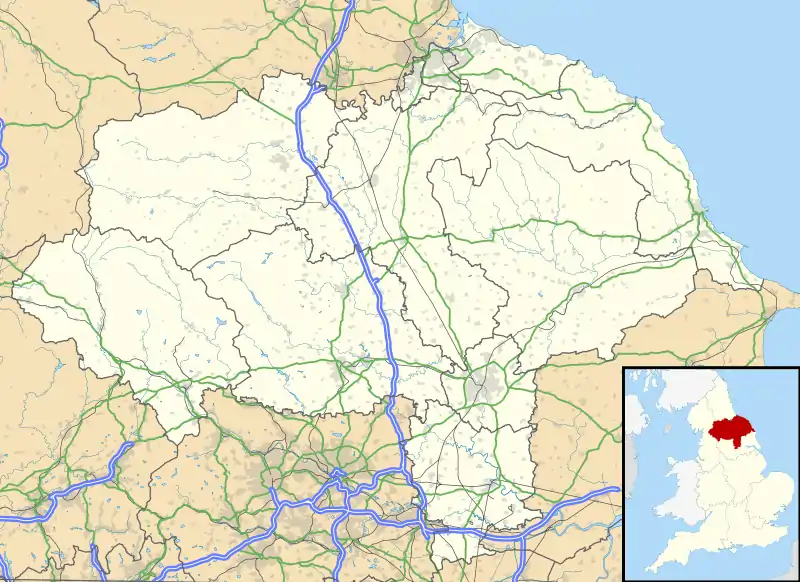East Rounton
East Rounton is a village and civil parish in the Hambleton district of North Yorkshire, England. It is about 1 mile west of the A19 and 8 miles north-east of Northallerton. It is on the River Wiske and West Rounton is nearby. The population taken at the 2011 Census was less than 100. Details are included in the civil parish of West Rounton.
| East Rounton | |
|---|---|
 East Rounton Location within North Yorkshire | |
| OS grid reference | NZ422033 |
| District | |
| Shire county | |
| Region | |
| Country | England |
| Sovereign state | United Kingdom |
| Post town | NORTHALLERTON |
| Postcode district | DL6 |
| Police | North Yorkshire |
| Fire | North Yorkshire |
| Ambulance | Yorkshire |

East Rounton was the site of Rounton Grange, a country house designed by the architect Philip Webb in 1872 to 1876 for the industrialist Sir Isaac Lowthian Bell. It was demolished in 1953.[1]
Early history
The area was named “Rantune” in the Domesday survey of 1086, valued at £2, and with The Lord being the King, William the Conqueror.[2] The Church of St Lawrence is thought to probably date back to the 13th century, but at least to 1483. It was restored by Sir Isaac Lowthian Bell in 1884. In a field to the north of the church are the remains of the medieval village. The village appears on maps of 1577 and 1611, but is absent from later maps of 1645 and 1720. There is an 18th century bridge over the River Wiske, where an old inn used to stand; the Black Horse.
Recent history
In 1866, Sir Isaac Lowthian Bell, a scientist and ironmaster (Dorman Long – Middlesbrough) and early patron of the Arts and Crafts movement,[3] bought the estate. Architect Philip Webb was commissioned by Lowthian Bell to design Rounton Grange to replace an existing farmhouse. Building commenced in 1872 and completed in 1876, creating a “landmark of nineteenth century domestic architecture” in the view of Country Life magazine.[4] William Morris and Sir Edward Burne-Jones were engaged as interior designers.[5] Additional buildings were added by Lowthian Bell’s son, Sir Hugh Bell, using George Jack as architect, including the East Lodge in 1909 linked by outside electric lights to the Grange. The Rounton Village Hall, built in 1907 by Tarrans of Hutton Rudby, funded by Sir Hugh & Lady Bell, now includes a War Memorial at the front. The hall is adjoined on either side by three cottages (The Square). It was used during the First World War as a hospital for wounded soldiers, and is still in use today by local residents. With two sets of Death Duties suffered in the early 1900s, the Grange became too expensive to maintain. It was offered to the National Trust, but was declined due to lack of an endowment. The Bell family moved to Mount Grace Priory in 1926 and the contents of the Grange were sold in 1932. The house was demolished in 1953 and the gardens abandoned. Although the Grange no longer exists, various estate buildings still do, built in the Arts & Crafts style and mostly designed by Philip Webb. These include the Old Lodge, Home Farm, Garden House and walled gardens, the Coach House (used to hold the coaches and a horse-drawn steam-driven fire engine), the Motor House, Keeper’s Cottage (home of the gamekeeper to the Grange) and Rounton House, the latter designed by George Jack (Philip Webb’s assistant) in 1905 for the use of the estate manager. Pear Tree Cottage was originally the Rest House for sick or injured estate workers. The Old School House was the village school, opened in 1877 but closed in 1967. Opposite the Village Hall, The School House was the residence of the headmistress. The Old Post Office was the village shop and post office / telegram office, closing in 1979. A stained-glass window memorial to a local resident, Gertrude Bell, grand-daughter of Lowthian Bell, historian and extensive traveller, is included in The Church of St. Lawrence. It was made by Douglas Strachan and depicts Magdalen College, Oxford and Khadimain, Baghdad. Miss Bell was the subject of a film in 2015, “Queen of the Desert”, and of a documentary, “Letters from Baghdad”, the following year.[6]
References
- Peter Burman. "An Introduction to the East Rounton Estate" (PDF). Retrieved 28 February 2015.
- "East Rounton".
- Mathews, Margaret. "East Rounton Grange park and garden". Yorkshire Gardens Trust. Hambleton District Historic Designed Landscapes Project.
- "Rounton Grange". Country Life. 26 June 1915.
- Lawton, Derek R (2001). The Rountons, a brief history. Garden House Publishing. ISBN 0950699489.
- Felperin, Leslie (21 April 2017). "Letters from Baghdad review – Gertrude Bell gets the documentary she deserves". The Guardian. Retrieved 5 March 2019.
External links
![]() Media related to East Rounton at Wikimedia Commons
Media related to East Rounton at Wikimedia Commons